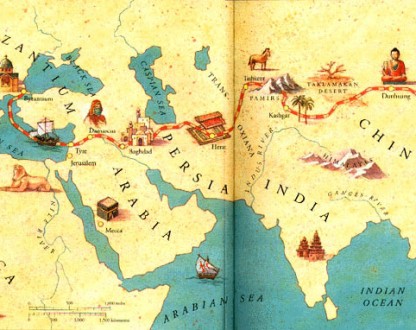Another piece building on my growing body of China-Central Asia work, this time for a new outlet The Commentator, but alongside my usual co-author Alex. For a more concentrated look at my work on this topic, please check out the other site I co-edit: http://www.chinaincentralasia.com
China and Turkey Revive Silk Road
By Alexandros Petersen and Raffaello Pantucci
on 22 May 2012 at 9am
The implications of the burgeoning Sino-Turkic relationship in Central Asia remain unexplored. Washington must act to guarantee everyone’s strategic objectives in the region
URUMQI, WESTERN CHINA – The leaders of the world’s fastest growing economies in Eurasia met in Beijing last month. Prime Minister Erdogan’s visit to China, coming soon after president-in-waiting Xi Jinping’s visit to Turkey might have heralded a new dawn of Sino-Turkic relations on the old Silk Road: in Central Asia.
This could be an opportunity for the United States to enlist these two dynamic economies to contribute to stability in the region once Western forces have withdrawn from Afghanistan. It could also emerge as an alternative to U.S. influence in the region. Much depends on how Washington approaches the revived relationship.
The mere fact that the visit took place in such a positive light is surprising in itself. It is just over two years ago thatErdogan used the word ‘genocide’ in comments about civil unrest here in Urumqi. Now, his first stop in China wasUrumqi. China and Turkey are now talking about cooperation at a variety of levels, from nuclear cooperation and other ‘new’ energies, increasing trade links, infrastructure projects, military cooperation and even Turkish assistance in helping develop Xinjiang. And beyond their borders, they discussed current events in Syria – in which both are playing a prominent diplomatic role – while also exploring what potential might exist for future cooperation in Central Asia.
Turkish businessmen have long had commercial links in Xinjiang due to a somewhat mutually intelligible language and the remnants of a so-called Pan-Turkism that Ankara pushed throughout Central Asia in the wake of the Cold War. These links have not extended to the rest of China. A massive trade gap exists between the two countries, with 2.5 billion USD of Turkish goods sold in China last year, compared with 21.6 billion USD of Chinese goods sold in Turkey.
In Central Asia, however, both Turkish and Chinese goods can be found at the markets. People are grateful for the cheap Chinese products, but are often willing to pay a premium for more specialized Turkish products. Wander around downtown Bishkek and you will find Turkish real-estate developers on every corner, but drive around Kyrgyzstan and you will find roads being built by Chinese state owned enterprises.
This parallelism extends into education, where Turkey has invested in large universities that offer scholarships for local students and an education focused on improving Turkic links. China has taken a more modest approach, offering language classes through Confucius Institutes that provide a labour force that can work as management for Chinese firms investing in the region and improve communication amongst the border traders going either way.
But neither power is seen as the dominant big brother in the region. Russian remains the lingua franca and visa free travel around the CIS means young Central Asians are more likely to work in Russia than elsewhere. American interests in Afghanistan mean that Washington’s focus is laser-like on security questions in the region, and Europe’s ambitious plans for engaging with the region have fallen foul of more pressing priorities. All three suffer from economies beset by domestic problems, and Central Asia is increasingly getting demoted in importance. China and Turkey, enjoying impressive growth, have clearly expressed an interest in growing their regional footprints.
As a NATO member, Turkey has served as a key provider of aid to Afghanistan, and China has investments in copper mines and natural gas fields. Their economic heft in Central Asia, in markets and with governments, could also become an important force-multiplier for U.S. efforts to facilitate a “New Silk Road” across Eurasia and through Afghanistan to provide development potential and contribute to long-term stability.
In discussions with policymakers and analysts in China and Turkey, a common refrain we have heard is that long-term stability is paramount for the growth of both countries’ investments in the region – a strategic interest they share with Washington. The U.S. State Department and CENTCOM would do well to coordinate the New Silk Road strategy with Beijing’s very similar Eurasian Land Bridge project and Turkey’s trans-continental trade networks across the Caspian.
At the moment, however, U.S. policymakers’ understandable fixation on troop withdrawals means the longer-term implications of the burgeoning Sino-Turkic relationship in Central Asia are unexplored. If the United States and its allies work in a vacuum separate from Chinese and Turkish activities, these implications could form a platform for an even more Western-sceptic sentiment than exists in the region at the moment.
Washington has already done some work to engage with both powers in the region, but more focused attention on this would help guarantee that everyone’s strategic objectives of a secure and stable region are ensured.
Alexandros Petersen is author of The World Island: Eurasian Geopolitics and the Fate of the West. Raffaello Pantucci is a Visiting Scholar at the Shanghai Academy of Social Sciences. Their joint research is available at: www.chinaincentralasia.com


[…] the former Soviet state. The country is a natural stop along the old Silk Road trading route, which is in the process of being revived in modern form by China and Turkey – two key powers that essentially bookend the entire region from the east […]